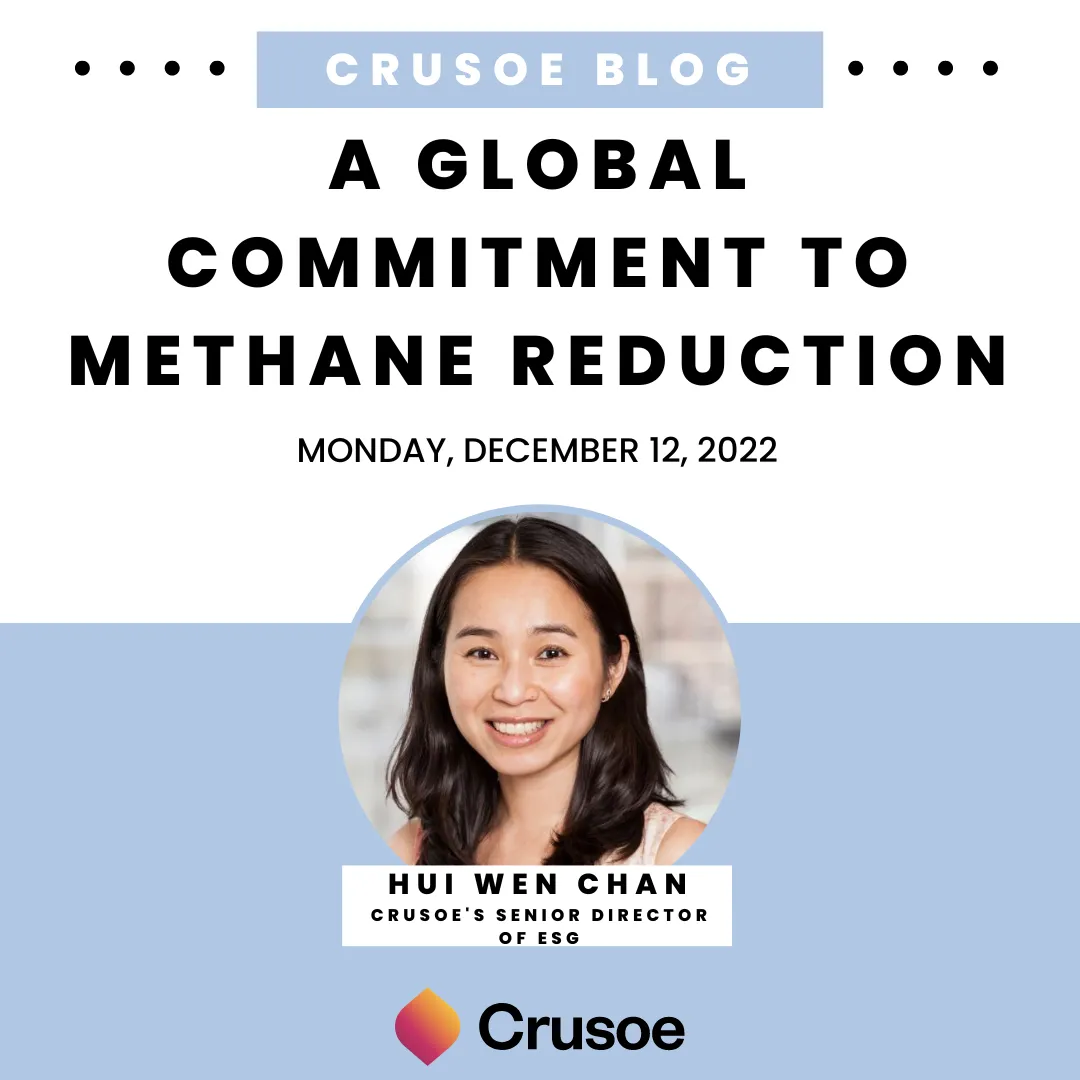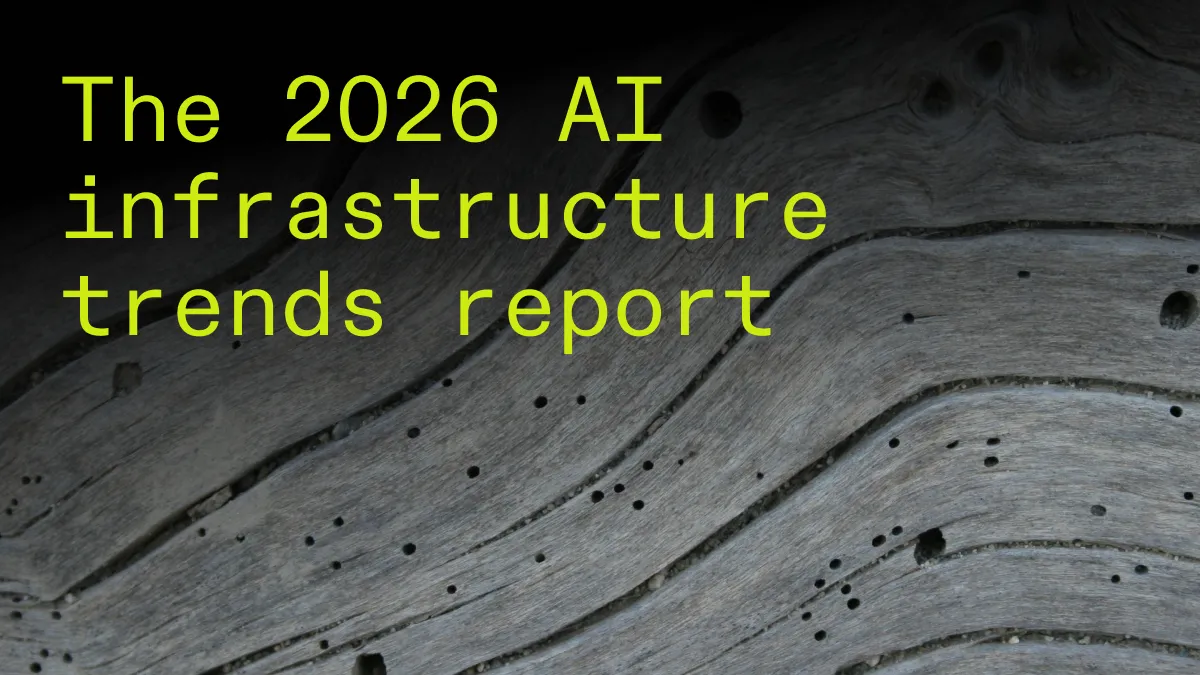A global commitment to methane reduction
In our December blog post, “A Global Commitment to Methane Reduction”, Crusoe’s Senior Director of ESG Hui Wen Chan takes a look at where things stand in the international community’s progress on methane reductions and how Crusoe is continuing to demonstrate its commitment to methane emissions reduction.

A Global Commitment to Methane Reduction
Earlier this year, we wrote about the importance of Crusoe’s efforts to minimize the harm of methane emissions through flare reduction. As we explained then,
Last year, in its Sixth Assessment Report, the United Nations Intergovernmental Panel on Climate Change (UN IPCC) concluded that deep reductions of greenhouse gas emissions, particularly reduction of methane emissions, would be needed to mitigate global warming. In response, at the UN Climate Change Conference COP26, more than 100 countries (representing more than 70% of global GDP) signed the Global Methane Pledge, promising collective action to reduce global methane emissions by at least 30 percent by 2030.
Methane reduction remains a high priority for the globe. Last month, we evaluated Crusoe’s contribution to emissions reduction by measuring our GHG footprint, including our Scope 4 avoided emissions. This month, following the recent COP27 UN climate conference in Egypt, we wanted to provide an update about the international community’s progress on methane reductions.
Ultimately, the rapid reduction of methane emissions is the best and most cost-effective strategy we have to bend the curve on climate change and limit global warming.
The Bad News
When we talk about methane, we’re talking about a powerful—but short-lived—climate pollutant that accounts for about half of the net one-degree Celsius rise in global average temperature since the pre-industrial era. Methane is over 80 times more powerful than CO2 at trapping heat in Earth’s atmosphere over a 20-year timeframe.
Unfortunately, methane emissions continue to rise unabated globally.Research from the National Oceanic and Atmospheric Administration (NOAA) showed the largest annual increase in atmospheric methane in 2021 since systematic measurements began in 1983.
In addition, a number of measurement-based studies have consistently found that the methane emissions from the oil and gas industry are higher than estimated in EPA inventories. The Environmental Defense Fund’s Permian Methane Analysis Project found that three times more methane is leaked in the Permian basin than the EPA estimates. Most recently, a University of Michigan study of 300+ flares found that flaring releases five times more methane in the U.S. than previously estimated.
If we do not drastically cut methane emissions the global community’s hopes of meeting our climate goals will likely not be achievable.
The Good News
There is a different path forward.
At COP27, the United States and European Union announced that more than 150 governments have now signed on to the Global Methane Pledge—about 50 more than when the initiative was introduced last year. Furthermore, more than 50 countries have adopted methane action plans or are working to develop one.
Here in the U.S., we are taking significant steps to limit methane emissions.
In November, the EPA released a supplemental proposal that updates, strengthens, and expands the agency’s previous efforts to reduce methane emissions from the oil and gas sector. The proposed rules would reduce the industry’s methane emissions by 87% below 2005 levels through requirements that include limits on the flaring of associated gas from oil wells by requiring owners or operators to route associated gas to a sales line, reinject it into a well for enhanced oil recovery, or use the gas for fuel or another beneficial purpose.
And the U.S. is not alone in its efforts. Our neighbors, Canada and Mexico are also making strides. Canada published a proposed regulatory framework to achieve at least a 75 percent reduction from the oil and gas sector by 2030 relative to 2012. In Mexico, PEMEX, the state-owned oil and gas company, is creating a plan for methane and flaring reduction by the first half of 2023.
Elsewhere in the world, Nigeria (one of the top gas flaring countries according to the World Bank) and Colombia became the first African and South American countries, respectively, to regulate methane emissions from the oil and gas sector, while Malaysia’s national oil company and regulator, PETRONAS, announced a target to reduce methane emissions 50 percent by 2025. Egypt launched an Oil and Gas Methane Roadmap framework with core elements of a comprehensive methane reduction approach.
It’s important to note that achieving our climate goals will require collective commitment and action from companies in key industries, in addition to governments. That’s why it’s a positive development to see the oil and gas sector making efforts to limit emissions. It was a key topic at this year’s ADIPEC, the world’s largest oil and gas conference, which included a decarbonization conference dedicated to subjects like addressing the methane challenge. At the conference, Crusoe’s co-founder and President, Cully Cavness, spoke about the critical role that mitigating methane emissions plays in enabling us to achieve global climate and emissions goals, and how Crusoe’s digital flare mitigation solution can help the oil and gas sector reduce methane emissions by offering a beneficial way to utilize flared natural gas to power data centers.
Across the international community, we are seeing initiatives like the Oil and Gas Methane Partnership and the World Bank Global Gas Flaring Reduction Partnership (GGFR) bring together multi-stakeholder partners, including oil and gas companies. These efforts will help to improve data and reporting on methane emissions, while identifying the most effective solutions to bring our methane reduction targets within reach.
Crusoe’s Commitment to Methane Emissions Reduction
Crusoe’s stance has always been that we should reduce energy waste and use flared gas for a beneficial purpose. We’ve limited our operations to sites where there is no viable alternative to flaring, working with operators that are unable to route gas to a sales line and harnessing gas that would otherwise be flared to power data centers on site. We provide a proven solution—one that has been highlighted as “innovative” by the World Bank GGFR—that can help reduce methane emissions in the oil and gas sector. Crusoe is committed to our goal of reducing flaring, and we look forward to growing and expanding to meet the scale of the world’s methane challenge.
(See Minimizing The Harm Of Methane Emissions Through Flare Reduction for more information on Crusoe’s Digital Flare Mitigation® technology)
Additionally, we recently signed on to the Crypto Climate Accord. Inspired by the Paris Climate Agreement, the accord is a private-sector-led initiative for the entire crypto community focused on decarbonizing the cryptocurrency industry.
From reducing emissions in the oil and gas industry to being part of the effort to decarbonize the cryptocurrency and cloud computing industries, we continue to advance our mission of aligning the future of computing with the future of the climate.



